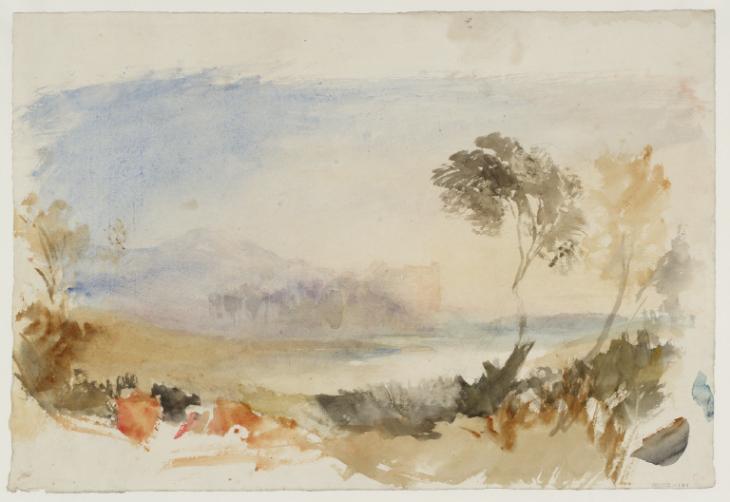Joseph Mallord William Turner Linlithgow Palace c.1821
Joseph Mallord William Turner,
Linlithgow Palace
c.1821
Joseph Mallord William Turner 1775–1851
Linlithgow Palace c.1821
D25316
Turner Bequest CCLXIII 194
Turner Bequest CCLXIII 194
Pencil and watercolour on white wove paper, 253 x 371 mm
Watermark ‘J Whatman | Turkey Mill | 1820’
Blind-stamped with Turner Bequest monogram towards bottom right
Inscribed in red ink ‘194’ bottom right (faded)
Stamped in black ‘CCLXIII – 194’ bottom right
Watermark ‘J Whatman | Turkey Mill | 1820’
Blind-stamped with Turner Bequest monogram towards bottom right
Inscribed in red ink ‘194’ bottom right (faded)
Stamped in black ‘CCLXIII – 194’ bottom right
Accepted by the nation as part of the Turner Bequest 1856
Exhibition history
1937
Watercolours from the Turner Bequest [Loan Series C], Towner Art Gallery, Eastbourne, January–March 1937, Graves Art Gallery, Sheffield, September 1946– February 1947,Wakefield Art Gallery, February–April 1960 (no catalogue but frame no.7, as ‘Study for a “Rivers of England” subject’).
1953
J.M.W. Turner R.A. 1775–1851: Pictures from Public and Private Collections in Great Britain, Whitechapel Art Gallery, London, February–March 1953 (156, as ‘Study for a “Rivers of England” Subject’, c.1820–30).
1980
Turner at the Bankside Gallery: Drawings & Water-colours of British River Scenes from the British Museum, Bankside Gallery, London, November–December 1980 (65, as ‘Kirkstall, from the river (?)’, c.1824, reproduced in colour).
1997
Turner’s Watercolour Explorations 1810–1842, Tate Gallery, London, February–June 1997, Southampton City Art Gallery, June–September (46, as ‘Study for “Linlithgow Palace”’, c.1821, reproduced in colour).
1999
Turner and Sir Walter Scott: The Provincial Antiquities and Picturesque Scenery of Scotland, National Gallery of Scotland, Edinburgh, December 1999–March 2000 (28, as ‘Colour Study for Linlithgow Palace’, c.1821, reproduced in colour).
2007
Colour and Line: Turner’s Experiments [second hang], Tate Britain, London, November 2007–October 2008 (no catalogue, as ‘Study for “Linlithgow Palace”’).
References
1820
A.J. Finberg, A Complete Inventory of the Drawings of the Turner Bequest, London 1909, vol.II, p.829, CCLXIII 194, as ‘Kirkstall, from the river (?)’, c.1820–30.
1820
Bryan Robertson and Sir John Rothenstein, J.M.W. Turner R.A. 1775–1851: An Exhibition of Pictures from Public and Private Collections in Great Britain, exhibition catalogue, Whitechapel Art Gallery, London 1953, p.25 no.156, as ‘Study for a “Rivers of England” Subject’, c.1820–30.
1824
Michael Spender and Malcolm Fry, Turner at the Bankside Gallery: Catalogue of an Exhibition of Drawings & Water-colours of British River Scenes from the British Museum, exhibition catalogue, Bankside Gallery, London 1980, p.140 no.65, as ‘Kirkstall, from the river (?)’, c.1824, reproduced in colour p.141.
1821
Eric Shanes, Turner’s Watercolour Explorations 1810–1842, exhibition catalogue, Tate Gallery, London 1997, pp.28, 63 no.46, as ‘Study for “Linlithgow Palace”’, c.1821, reproduced in colour, 101 Appendix I ‘Scotland’.
1821
Katrina Thomson, Turner and Sir Walter Scott: The Provincial Antiquities and Picturesque Scenery of Scotland, exhibition catalogue, National Gallery of Scotland, Edinburgh 1999 p.31, 88 no.28, as ‘Colour Study for Linlithgow Palace’, c.1821, pl.15 (colour).
This relatively developed ‘colour beginning’ is a study for the watercolour Linlithgow Palace (Manchester Art Gallery),1 unusually fully signed and dated ‘JMW Turner RA Sept 14 1821’ and showing the ruined medieval palace from the north-east beside Linlithgow Loch, fifteen miles west of Edinburgh, with the imposing crown spire of St Michael’s Parish Church beyond to its left. It was engraved in 1822 (Tate impressions: T04498, T06065) for Walter Scott’s Provincial Antiquities of Scotland (see the Introduction to this section) and, as discussed by Thomas Ardill in his catalogue entries, was based on some of the many pencil drawings around the site in the 1818 Scotch Antiquities sketchbook, particularly Tate D13679, D13680 (Turner Bequest CLXVII 53, 53a) and a double-page sketch in the Edinburgh 1818 sketchbook (Tate D13514–D13515; CLXVI 33a–34).2
Finberg tentatively suggested ‘Kirkstall, from the river (?)’3 as the subject, presumably recalled the 1824 Rivers of England watercolour (Tate D18146; Turner Bequest CCVIII M),4 with its hills, ruins, water, trees and cows in a fundamentally similar arrangement as here,5 but the direct relationship with the Linlithgow subject is indisputable. Despite the closeness of this work to the finished watercolour, including the two trees framing the view on the right and a variation on the variegated foreground group of cows, it was not until 1997 that Eric Shanes first published the connection.6 He suggested that given Turner’s ‘customary speed of production ... the present work might easily have been created on the same day’7 as the 14 September watercolour, and noted that the fall of the light from the right in both cases indicates an evening scene.
Katrina Thomson observes how the present work ‘establishes the peaceful, golden atmosphere ... in which the palace and its landscape are suffused by the gentle radiance of a dipping sun.’8 Another watercolour study, Tate D25325 (Turner Bequest CCLXIII 203), shows Turner contemplating a completely different treatment of the subject.
Technical notes:
The blue of the sky remains particularly fresh, and has a slightly speckled appearance where it has remained on the sized surface of the sheet; it has pooled a little there and in the outlines of the Whatman watermark towards the top left.
Verso:
Blank; inscribed by ?John Ruskin in pencil ‘AB 144 P’ bottom right; inscribed in pencil ‘33’ right of centre, ascending vertically; inscribed in pencil ‘CCLXIII | 194’ bottom right; stamped in black with Turner Bequest monogram over ‘CCLXIII – 194’ bottom left; inscribed in pencil ‘D.25316’ bottom left.
Matthew Imms
July 2016
How to cite
Matthew Imms, ‘Linlithgow Palace c.1821 by Joseph Mallord William Turner’, catalogue entry, July 2016, in David Blayney Brown (ed.), J.M.W. Turner: Sketchbooks, Drawings and Watercolours, Tate Research Publication, February 2017, https://www

